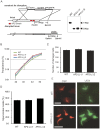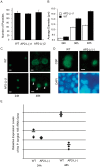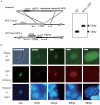Identification of an AP2-family protein that is critical for malaria liver stage development
- PMID: 23144823
- PMCID: PMC3492389
- DOI: 10.1371/journal.pone.0047557
Identification of an AP2-family protein that is critical for malaria liver stage development
Abstract
Liver-stage malaria parasites are a promising target for drugs and vaccines against malaria infection. However, little is currently known about gene regulation in this stage. In this study, we used the rodent malaria parasite Plasmodium berghei and showed that an AP2-family transcription factor, designated AP2-L, plays a critical role in the liver-stage development of the parasite. AP2-L-depleted parasites proliferated normally in blood and in mosquitoes. However, the ability of these parasites to infect the liver was approximately 10,000 times lower than that of wild-type parasites. In vitro assays showed that the sporozoites of these parasites invaded hepatocytes normally but that their development stopped in the middle of the liver schizont stage. Expression profiling using transgenic P. berghei showed that fluorescent protein-tagged AP2-L increased rapidly during the liver schizont stage but suddenly disappeared with the formation of the mature liver schizont. DNA microarray analysis showed that the expression of several genes, including those of parasitophorous vacuole membrane proteins, was significantly decreased in the early liver stage of AP2-L-depleted parasites. Investigation of the targets of this transcription factor should greatly promote the exploration of liver-stage antigens and the elucidation of the mechanisms of hepatocyte infection by malaria parasites.
Conflict of interest statement
Figures




Similar articles
-
Exoerythrocytic Plasmodium parasites secrete a cysteine protease inhibitor involved in sporozoite invasion and capable of blocking cell death of host hepatocytes.PLoS Pathog. 2010 Mar 26;6(3):e1000825. doi: 10.1371/journal.ppat.1000825. PLoS Pathog. 2010. PMID: 20361051 Free PMC article.
-
An ApiAp2 Transcription Factor with a Dispensable Role in Plasmodium berghei Life Cycle.ACS Infect Dis. 2024 Jun 14;10(6):1904-1913. doi: 10.1021/acsinfecdis.4c00240. Epub 2024 May 16. ACS Infect Dis. 2024. PMID: 38752809
-
RNA-Seq Analysis Illuminates the Early Stages of Plasmodium Liver Infection.mBio. 2020 Feb 4;11(1):e03234-19. doi: 10.1128/mBio.03234-19. mBio. 2020. PMID: 32019802 Free PMC article.
-
The malaria sporozoite's journey into the liver.Infect Agents Dis. 1996 Jun;5(3):182-9. Infect Agents Dis. 1996. PMID: 8805080 Review.
-
Moving on: How malaria parasites exit the liver.Mol Microbiol. 2024 Mar;121(3):328-340. doi: 10.1111/mmi.15141. Epub 2023 Aug 21. Mol Microbiol. 2024. PMID: 37602900 Review.
Cited by
-
Targetome Analysis of Malaria Sporozoite Transcription Factor AP2-Sp Reveals Its Role as a Master Regulator.mBio. 2023 Feb 28;14(1):e0251622. doi: 10.1128/mbio.02516-22. Epub 2023 Jan 9. mBio. 2023. PMID: 36622145 Free PMC article.
-
Toxoplasma transcription factor TgAP2XI-5 regulates the expression of genes involved in parasite virulence and host invasion.J Biol Chem. 2013 Oct 25;288(43):31127-38. doi: 10.1074/jbc.M113.486589. Epub 2013 Sep 10. J Biol Chem. 2013. PMID: 24025328 Free PMC article.
-
Same, same but different: Exploring Plasmodium cell division during liver stage development.PLoS Pathog. 2023 Mar 30;19(3):e1011210. doi: 10.1371/journal.ppat.1011210. eCollection 2023 Mar. PLoS Pathog. 2023. PMID: 36996035 Free PMC article. Review.
-
An ApiAP2 member regulates expression of clonally variant genes of the human malaria parasite Plasmodium falciparum.Sci Rep. 2017 Oct 25;7(1):14042. doi: 10.1038/s41598-017-12578-y. Sci Rep. 2017. PMID: 29070841 Free PMC article.
-
A Knockout Screen of ApiAP2 Genes Reveals Networks of Interacting Transcriptional Regulators Controlling the Plasmodium Life Cycle.Cell Host Microbe. 2017 Jan 11;21(1):11-22. doi: 10.1016/j.chom.2016.12.003. Cell Host Microbe. 2017. PMID: 28081440 Free PMC article.
References
-
- Hoffman SL, Goh LML, Luke TC, Schneider I, Le TP, et al. (2002) Protection of humans against malaria by immunization with radiation-attenuated Plasmodium falciparum sporozoites. Journal of Infectious Diseases 185: 1155–1164. - PubMed
-
- Mueller AK, Labaied M, Kappe SH, Matuschewski K (2005) Genetically modified Plasmodium parasites as a protective experimental malaria vaccine. Nature 433: 164–167. - PubMed
-
- Tarun AS, Dumpit RF, Camargo N, Labaied M, Liu P, et al. (2007) Protracted sterile protection with Plasmodium yoelii pre-erythrocytic genetically attenuated parasite malaria vaccines is independent of significant liver-stage persistence and is mediated by CD8+ T cells. J Infect Dis 196: 608–616. - PubMed
-
- White KL, Snyder HL, Krzych U (1996) MHC class I-dependent presentation of exoerythrocytic antigens to CD8+ T lymphocytes is required for protective immunity against Plasmodium berghei. J Immunol 156: 3374–3381. - PubMed
Publication types
MeSH terms
Substances
LinkOut - more resources
Full Text Sources
Medical
Molecular Biology Databases
Research Materials

